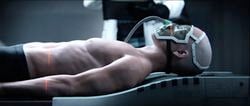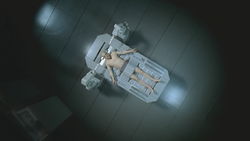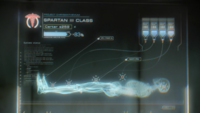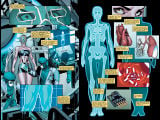Biological augmentation: Difference between revisions
From Halopedia, the Halo wiki
No edit summary |
mNo edit summary |
||
| Line 10: | Line 10: | ||
===ORION=== | ===ORION=== | ||
{{Main|ORION Project}} | {{Main|ORION Project}} | ||
The first major effort to create biochemically-augmented supersoldiers was known as [[Project ORION]]. The beginnings of the program can be traced back to [[2321]], when the [[Office of Naval Intelligence]] began to build upon bioengineering protocols developed during the Interplanetary Wars. However, after five military candidates were selected and tested, the project was declared ineffective and the candidates were returned to their respective chains of command.<ref name="enc44"/> The project was secretly relaunched by the [[Colonial Military Administration]] well over a century later in [[2491]], with the recruitment of 65 adult test subjects; hundreds more were added after the first batch completed their training. While the ORION operatives were highly successful, the project on the whole was deemed a failure due to many factors, among the most prominent being the high "washout" rate of the augmentations.<ref name="journal">'''[[Dr. Halsey's personal journal]]'''</ref> | The first major effort to create biochemically-augmented supersoldiers was known as [[Project ORION]]. The beginnings of the program can be traced back to [[2321]], when the [[Office of Naval Intelligence]] began to build upon bioengineering protocols developed during the Interplanetary Wars. However, after five military candidates were selected and tested, the project was declared ineffective and the candidates were returned to their respective chains of command.<ref name="enc44"/> The project was secretly relaunched by the [[Colonial Military Administration]] well over a century later in [[2491]], with the recruitment of 65 adult test subjects; hundreds more were added after the first batch completed their training. The ORION augmentations included enhancements to muscle density, lung capacity, vision, hearing and balance.<ref>'''[[Media:cochlear_tuning.ogg|cochlear_tuning Axon]]'''</ref> While the ORION operatives were highly successful, the project on the whole was deemed a failure due to many factors, among the most prominent being the high "washout" rate of the augmentations as well as the limited effectiveness of the enhancements themselves.<ref name="journal">'''[[Dr. Halsey's personal journal]]'''</ref> | ||
===SPARTAN-II=== | ===SPARTAN-II=== | ||
[[File:Prologue - Spartan augmentation 01.jpg|thumb|250px|[[John-117]] being prepared for his augmentations]] | [[File:Prologue - Spartan augmentation 01.jpg|thumb|250px|[[John-117]] being prepared for his augmentations]] | ||
{{Main|SPARTAN-II augmentation procedures}} | {{Main|SPARTAN-II augmentation procedures}} | ||
Research on the [[SPARTAN-II program]]'s augmentations began five years after the deactivation of the ORION Project. Headed by [[Catherine Halsey|Dr. Catherine Halsey]], early analysis concluded that next-generation candidates must have "more malleable, robust DNA structure and repair enzymes | Research on the [[SPARTAN-II program]]'s augmentations began five years after the deactivation of the ORION Project. Headed by [[Catherine Halsey|Dr. Catherine Halsey]], early analysis concluded that next-generation candidates must have "more malleable, robust DNA structure and repair enzymes" and be selected through a stringent genetic screening process to avoid the washout rates of the ORION program. Because of the requirements, the best suitable candidates who would adapt without severe side effects were those of prepubescent age. Thus, despite being highly unethical and illegal, it was decided that the program's trainees be drafted as children and augmented as they began to reach puberty.<ref name="journal"/> | ||
The SPARTAN-II augmentations included many previously-untested procedures, among them synthetic bone grafts, hormonal supplements, retinal surgery, intramuscular protein injections and major alteration of the subject's nervous system. While the SPARTAN-II augmentations would make the soldier significantly stronger and faster than an ORION operative, this came with a prize: out of 75 candidates, only 33 survived the augmentation procedures, with the rest either killed or maimed for life. However, the Spartans who did survive became the most effective soldiers to be ever fielded by humanity, with superhuman strength, reflexes and stamina as well as virtually unbreakable bones. To complement their biological augmentation, the SPARTAN-IIs were given state-of-the-art [[MJOLNIR Powered Assault Armor]] which interfaces with the wearer's nervous system and greatly boosts their strength and speed. When paired with a [[smart AI]] through a [[Spartan neural interface|specialized neural implant]], a Spartan's tactical awareness and reaction time are improved even further.<ref name="journal"/> | The SPARTAN-II augmentations included many previously-untested procedures, among them synthetic bone grafts, hormonal supplements, retinal surgery, intramuscular protein injections and major alteration of the subject's nervous system. While the SPARTAN-II augmentations would make the soldier significantly stronger and faster than an ORION operative, this came with a prize: out of 75 candidates, only 33 survived the augmentation procedures, with the rest either killed or maimed for life. However, the Spartans who did survive became the most effective soldiers to be ever fielded by humanity, with superhuman strength, reflexes and stamina as well as virtually unbreakable bones. To complement their biological augmentation, the SPARTAN-IIs were given state-of-the-art [[MJOLNIR Powered Assault Armor]] which interfaces with the wearer's nervous system and greatly boosts their strength and speed. When paired with a [[smart AI]] through a [[Spartan neural interface|specialized neural implant]], a Spartan's tactical awareness and reaction time are improved even further.<ref name="journal"/> | ||
Revision as of 01:28, June 6, 2014
Since the dawn of widespread spaceflight, humans have sought to use biochemical, surgical and cybernetic means to augment their bodies. While civilian applications for such technologies do exist, their obvious military advantages quickly saw them harnessed for the purposes of warfare. Basic performance-enhancing technologies have been commonplace among human militaries for centuries; however, extensive experimentation pushing the limits of the human body has historically been limited due to ethical concerns. A notable exception to this are the biochemical and cybernetic augmentations used in the SPARTAN programs, which represent the peak of human biological and cybernetic enhancement.[1]
History
Early efforts
Experimentation on the enhancement of the human body and mind has been a known concept since the 20th century. As medical technology and scientists' understanding of human biology continued to improve, human augmentation started to become a reality. The first human bioengineering protocols were implemented when humanity began to colonize their home system. Due to the baseline human body's ill-suitability for long-duration spaceflight and different planetary gravity conditions, the space explorers and colonists were given biochemical enhancements to enable their bodies to adjust to these challenges.[1]
As unrest began to brew in humanity's fledgling space territories, eventually breaking out as the Interplanetary War, biological augmentations were first appropriated for military use. Despite providing subtle enhancement in the areas of strength and speed, these augmentations were rather primitive in comparison to the supersoldiers created centuries later. However, they did encourage the UNSC to continue research into human enhancement.[1]
ORION
- Main article: ORION Project
The first major effort to create biochemically-augmented supersoldiers was known as Project ORION. The beginnings of the program can be traced back to 2321, when the Office of Naval Intelligence began to build upon bioengineering protocols developed during the Interplanetary Wars. However, after five military candidates were selected and tested, the project was declared ineffective and the candidates were returned to their respective chains of command.[1] The project was secretly relaunched by the Colonial Military Administration well over a century later in 2491, with the recruitment of 65 adult test subjects; hundreds more were added after the first batch completed their training. The ORION augmentations included enhancements to muscle density, lung capacity, vision, hearing and balance.[2] While the ORION operatives were highly successful, the project on the whole was deemed a failure due to many factors, among the most prominent being the high "washout" rate of the augmentations as well as the limited effectiveness of the enhancements themselves.[3]
SPARTAN-II

- Main article: SPARTAN-II augmentation procedures
Research on the SPARTAN-II program's augmentations began five years after the deactivation of the ORION Project. Headed by Dr. Catherine Halsey, early analysis concluded that next-generation candidates must have "more malleable, robust DNA structure and repair enzymes" and be selected through a stringent genetic screening process to avoid the washout rates of the ORION program. Because of the requirements, the best suitable candidates who would adapt without severe side effects were those of prepubescent age. Thus, despite being highly unethical and illegal, it was decided that the program's trainees be drafted as children and augmented as they began to reach puberty.[3]
The SPARTAN-II augmentations included many previously-untested procedures, among them synthetic bone grafts, hormonal supplements, retinal surgery, intramuscular protein injections and major alteration of the subject's nervous system. While the SPARTAN-II augmentations would make the soldier significantly stronger and faster than an ORION operative, this came with a prize: out of 75 candidates, only 33 survived the augmentation procedures, with the rest either killed or maimed for life. However, the Spartans who did survive became the most effective soldiers to be ever fielded by humanity, with superhuman strength, reflexes and stamina as well as virtually unbreakable bones. To complement their biological augmentation, the SPARTAN-IIs were given state-of-the-art MJOLNIR Powered Assault Armor which interfaces with the wearer's nervous system and greatly boosts their strength and speed. When paired with a smart AI through a specialized neural implant, a Spartan's tactical awareness and reaction time are improved even further.[3]
According to the Librarian, a geas she planted in the human genome 100,000 years earlier motivated humans to begin developing the Spartans' performance-enhancing technologies.[4] There are certain passing similarities between some of the Spartans' augmentations and the Forerunners' mutations, particularly those of the Warrior-Servant rate; namely the physical and neural enhancement present in both.
SPARTAN-III

- Main article: Project CHRYSANTHEMUM
Initiated by Colonel James Ackerson, the SPARTAN-III program built upon Dr. Halsey's pioneering work on the preceding SPARTAN-II project. The new augmentation set represented a major improvement over the previous program, all the while being cheaper than before: much less surgery was required, with most of the enhancements administered via chemical means. The selection criteria could be loosened, and the procedures' mortality rate could be eliminated to zero. Despite this, the resulting soldiers were in many ways equal to the SPARTAN-IIs, barring the latter's superior equipment and experience.[5][6]
SPARTAN-IV
- Main article: SPARTAN-IV Augmentation Program
The SPARTAN-IV program was the first supersoldier project after ORION to use volunteering adult subjects, something that had been discarded in the previous programs due to the technological and psychological challenges involved. Their augmentations incorporate versions of many of the procedures used in the preceding programs and add several new enhancements as well, including a number of improvements to the subject's internal organs.[7]
Other examples
While easily overshadowed by the Spartans' extensive augmentation, medical, biochemical and technological conveniences do nonetheless have a pervasive presence in various areas of human society.
UNSC personnel are equipped with neural implants, more sophisticated models of which—typically issued to ship captains—enable a human mind to interface with computer systems and receive or send information. Advanced mechanical prosthetics have also been developed, although such technology is used solely for the purpose of replacing lost limbs rather than supplanting existing ones for any possible advantages they may have over biological limbs.[8] Further medical advances have been made in areas not directly related to physical performance but nonetheless improving humans' quality of life. By the 22nd century, cancer had been virtually eradicated from the human genome, with any isolated cases that do occur being easy to treat.[9]
As a crude replication of the technologies used to forge the Spartans, human Insurrectionists use "rumbledrugs" which degenerate the user's body but grant them superhuman abilities for a short time, potentially giving them a fighting chance against Spartans.[9]
Gallery
A screen monitoring Carter-A259's CHRYSANTHEMUM augmentations
SPARTAN-IV Sarah Palmer undergoing her augmentations
Sources
- ^ a b c d Halo Encyclopedia, page 44
- ^ cochlear_tuning Axon
- ^ a b c Dr. Halsey's personal journal
- ^ Halo 4, campaign level Reclaimer
- ^ Halo: Ghost of Onyx, page 63
- ^ Halo: Ghosts of Onyx, pages 101-102
- ^ Halo: Initiation, Issue #2
- ^ Halo: Contact Harvest, page 81
- ^ a b Halo: Evolutions - Essential Tales of the Halo Universe,"Midnight in the Heart of Midlothian"
| |||||||||||||||||


